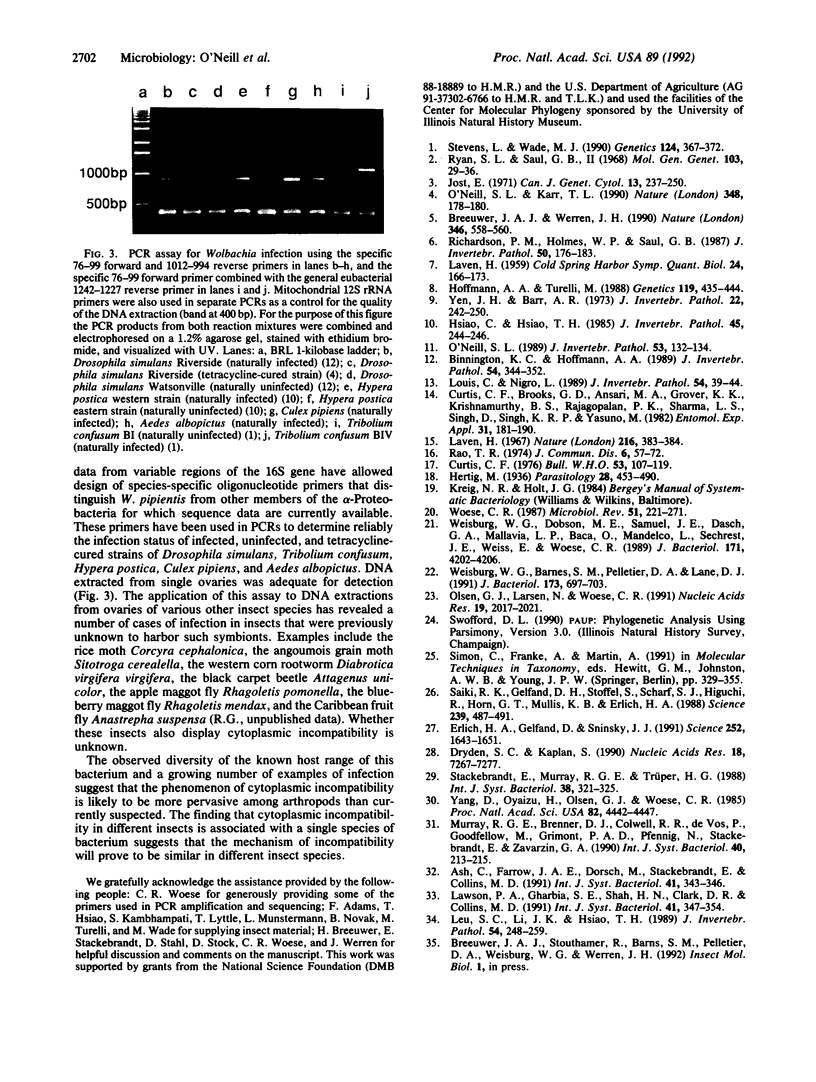Abstract
Bacterial endosymbionts of insects have long been implicated in the phenomenon of cytoplasmic incompatibility, in which certain crosses between symbiont-infected individuals lead to embryonic death or sex ratio distortion. The taxonomic position of these bacteria has, however, not been known with any certainty. Similarly, the relatedness of the bacteria infecting various insect hosts has been unclear. The inability to grow these bacteria on defined cell-free medium has been the major factor underlying these uncertainties. We circumvented this problem by selective PCR amplification and subsequent sequencing of the symbiont 16S rRNA genes directly from infected insect tissue. Maximum parsimony analysis of these sequences indicates that the symbionts belong in the alpha-subdivision of the Proteobacteria, where they are most closely related to the Rickettsia and their relatives. They are all closely related to each other and are assigned to the type species Wolbachia pipientis. Lack of congruence between the phylogeny of the symbionts and their insect hosts suggest that horizontal transfer of symbionts between insect species may occur. Comparison of the sequences for W. pipientis and for Wolbachia persica, an endosymbiont of ticks, shows that the genus Wolbachia is polyphyletic. A PCR assay based on 16S primers was designed for the detection of W. pipientis in insect tissue, and initial screening of insects indicates that cytoplasmic incompatibility may be a more general phenomenon in insects than is currently recognized.
Full text
PDF



Images in this article
Selected References
These references are in PubMed. This may not be the complete list of references from this article.
- Ash C., Farrow J. A., Dorsch M., Stackebrandt E., Collins M. D. Comparative analysis of Bacillus anthracis, Bacillus cereus, and related species on the basis of reverse transcriptase sequencing of 16S rRNA. Int J Syst Bacteriol. 1991 Jul;41(3):343–346. doi: 10.1099/00207713-41-3-343. [DOI] [PubMed] [Google Scholar]
- Breeuwer J. A., Werren J. H. Microorganisms associated with chromosome destruction and reproductive isolation between two insect species. Nature. 1990 Aug 9;346(6284):558–560. doi: 10.1038/346558a0. [DOI] [PubMed] [Google Scholar]
- Curtis C. F. Population replacement in Culex fatigans by means of cytoplasmic incompatibility. 2. Field cage experiments with overlapping generations. Bull World Health Organ. 1976;53(1):107–119. [PMC free article] [PubMed] [Google Scholar]
- Dryden S. C., Kaplan S. Localization and structural analysis of the ribosomal RNA operons of Rhodobacter sphaeroides. Nucleic Acids Res. 1990 Dec 25;18(24):7267–7277. doi: 10.1093/nar/18.24.7267. [DOI] [PMC free article] [PubMed] [Google Scholar]
- Erlich H. A., Gelfand D., Sninsky J. J. Recent advances in the polymerase chain reaction. Science. 1991 Jun 21;252(5013):1643–1651. doi: 10.1126/science.2047872. [DOI] [PubMed] [Google Scholar]
- Hoffmann A. A., Turelli M. Unidirectional incompatibility in Drosophila simulans: inheritance, geographic variation and fitness effects. Genetics. 1988 Jun;119(2):435–444. doi: 10.1093/genetics/119.2.435. [DOI] [PMC free article] [PubMed] [Google Scholar]
- Jost E. Meiosis in the male of Culex pipiens and Aedes albopictus and fertilization in the Culex pipiens-complex. Can J Genet Cytol. 1971 Jun;13(2):237–250. doi: 10.1139/g71-041. [DOI] [PubMed] [Google Scholar]
- LAVEN H. Speciation by cytoplasmic isolation in the Culex pipiens-complex. Cold Spring Harb Symp Quant Biol. 1959;24:166–173. doi: 10.1101/sqb.1959.024.01.017. [DOI] [PubMed] [Google Scholar]
- Laven H. Eradication of Culex pipiens fatigans through cytoplasmic incompatibility. Nature. 1967 Oct 28;216(5113):383–384. doi: 10.1038/216383a0. [DOI] [PubMed] [Google Scholar]
- Lawson P. A., Gharbia S. E., Shah H. N., Clark D. R., Collins M. D. Intrageneric relationships of members of the genus Fusobacterium as determined by reverse transcriptase sequencing of small-subunit rRNA. Int J Syst Bacteriol. 1991 Jul;41(3):347–354. doi: 10.1099/00207713-41-3-347. [DOI] [PubMed] [Google Scholar]
- O'Neill S. L., Karr T. L. Bidirectional incompatibility between conspecific populations of Drosophila simulans. Nature. 1990 Nov 8;348(6297):178–180. doi: 10.1038/348178a0. [DOI] [PubMed] [Google Scholar]
- Olsen G. J., Larsen N., Woese C. R. The ribosomal RNA database project. Nucleic Acids Res. 1991 Apr 25;19 (Suppl):2017–2021. doi: 10.1093/nar/19.suppl.2017. [DOI] [PMC free article] [PubMed] [Google Scholar]
- Ryan S. L., Saul G. B., 2nd Post-fertilization effect of incompatibility factors in Mormoniella. Mol Gen Genet. 1968;103(1):29–36. doi: 10.1007/BF00271154. [DOI] [PubMed] [Google Scholar]
- Saiki R. K., Gelfand D. H., Stoffel S., Scharf S. J., Higuchi R., Horn G. T., Mullis K. B., Erlich H. A. Primer-directed enzymatic amplification of DNA with a thermostable DNA polymerase. Science. 1988 Jan 29;239(4839):487–491. doi: 10.1126/science.2448875. [DOI] [PubMed] [Google Scholar]
- Stevens L., Wade M. J. Cytoplasmically inherited reproductive incompatibility in Tribolium flour beetles: the rate of spread and effect on population size. Genetics. 1990 Feb;124(2):367–372. doi: 10.1093/genetics/124.2.367. [DOI] [PMC free article] [PubMed] [Google Scholar]
- Weisburg W. G., Barns S. M., Pelletier D. A., Lane D. J. 16S ribosomal DNA amplification for phylogenetic study. J Bacteriol. 1991 Jan;173(2):697–703. doi: 10.1128/jb.173.2.697-703.1991. [DOI] [PMC free article] [PubMed] [Google Scholar]
- Weisburg W. G., Dobson M. E., Samuel J. E., Dasch G. A., Mallavia L. P., Baca O., Mandelco L., Sechrest J. E., Weiss E., Woese C. R. Phylogenetic diversity of the Rickettsiae. J Bacteriol. 1989 Aug;171(8):4202–4206. doi: 10.1128/jb.171.8.4202-4206.1989. [DOI] [PMC free article] [PubMed] [Google Scholar]
- Woese C. R. Bacterial evolution. Microbiol Rev. 1987 Jun;51(2):221–271. doi: 10.1128/mr.51.2.221-271.1987. [DOI] [PMC free article] [PubMed] [Google Scholar]
- Yang D., Oyaizu Y., Oyaizu H., Olsen G. J., Woese C. R. Mitochondrial origins. Proc Natl Acad Sci U S A. 1985 Jul;82(13):4443–4447. doi: 10.1073/pnas.82.13.4443. [DOI] [PMC free article] [PubMed] [Google Scholar]
- Yen J. H., Barr A. R. The etiological agent of cytoplasmic incompatibility in Culex pipiens. J Invertebr Pathol. 1973 Sep;22(2):242–250. doi: 10.1016/0022-2011(73)90141-9. [DOI] [PubMed] [Google Scholar]



